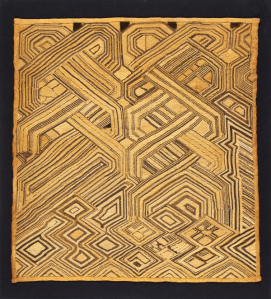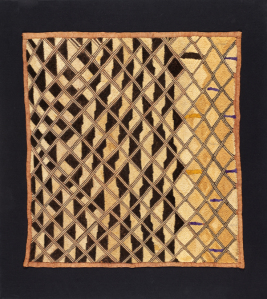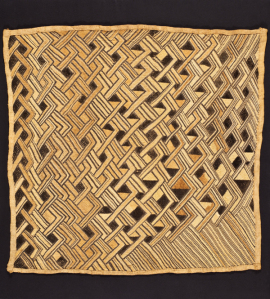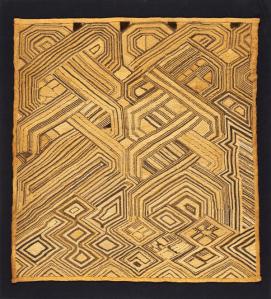There is no doubt that geometrical solutions have been a kind of “language” that has aided our complex social interaction from the very beginning. Although for each culture its origins, meanings, and evolutional usage would vary profoundly, its pervasive presence seems to suggest a deep and abiding function that mere words fail to provide. Thus we are people of “signs”—perhaps no better illustrated than by the current installation of textiles by the African Kuba people on view now.

Late 19th–Early 20th Century, gift of the 2009 Collectors Committee
The Kuba Kingdom is situated in the middle of the Democratic Republic of the Congo, nestled in a fertile forest and savanna fed by three rivers. The culture itself is primarily a complex hierarchical social structure where the royals, in masks of various sizes with geometrical meaning, are portrayed as intricate manifestations of the nature spirits casting out evil, or as intermediaries between the gods and people. At the center of their artistic innovations and competition of cloth and mask is the King, Mwaash aMbooy. The most ornate and sumptuous of these precious cloths and masks are given great fanfare; distinctive motifs are introduced into the Kuba repertory and can even be signed by the individual designer.

Late 19th–Early 20th Century, gift of the 2009 Collectors Committee

Late 19th–Early 20th Century, gift of the 2009 Collectors Committee
Beside the sheer artistry behind these textiles, what is so unique is their creation. The men are responsible for the cultivation of the raffia palm and its weaving. The women embroider with dyed raffia to create the plush pile. Each ceremonial cloth, a singularity, has an insistent, dazzling inventiveness that calls the Kuba to celebration. It is said that they are a people who cannot leave a surface without ornament. Geometric forms seem to place them in their knowable universe; the mystical quality of nature lies in its abstract entity. Although it is never made entirely clear why or how this deeply spiritual impulse, compulsion, and obligation generated into the Kuba universe as a geometrical communication, it could be suggested that Woot, the first man (the Kuba are also known as “the Children of Woot”), a pattern of utter intricacies, is feared, honored, and worshiped through these complex though dazzling displays of geometrical signs.



